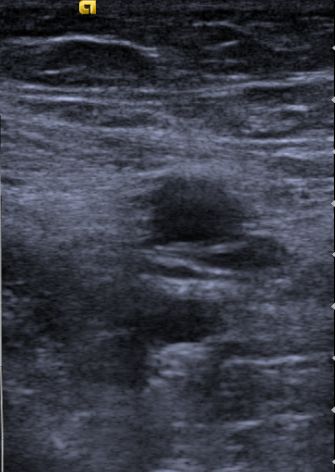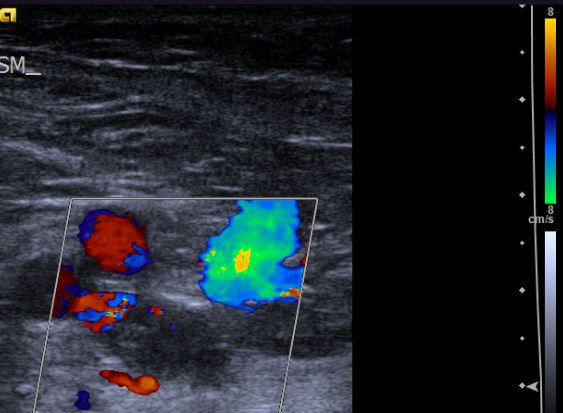| Punkte | Klinisches Merkmal |
| 1 | aktive oder behandelte Krebserkrankung in den letzten 6 Monaten |
| 1 | Lähmung, Parese oder kürzliche Gipsimmobilisation der unteren Extremitäten |
| 1 | Bettruhe (länger als 3 Tage); große OP (innerhalb der letzten 12 Wochen) |
| 1 | Schmerz/Verhärtung entlang des tiefen Venensystems |
| 1 | Schwellung des gesamten Beins bis zum Oberschenkel |
| 1 | Schwellung Unterschenkel > 3 cm zur Gegenseite |
| 1 | eindrückbares Ödem am symptomatischen Bein |
| 1 | erweiterte oberflächliche (nicht variköse) Kollateralvene |
| 1 | bereits zuvor dokumentierte tiefe Venenthrombose |
| -2 | alternative Diagnose ebenso wahrscheinlich wie TVT |
- Niedrig-Risikogruppe: Score - Summe bis 1
- Hoch - Risikogruppe: Score - Summe > 1
| Punkte | Merkmal | Odds Ratio (95% CI) |
| 2 | Magen-Ca, Pankreas-Ca | 4.3 (1.2–15.6) |
| 1 | Tumoren: Lunge, Lymphom, gyn. Tumoren, Blase, Hoden | 1.5 (0.9–2.7) |
| 1 | Thrombozyten ≥ 350.000/mm3 | 1.8 (1.1–3.2) |
| 1 | Hb <10 g/dl | 2.4 (1.4–4.2) |
| 1 | Leukozyten >11.000/mm3 | 2.2 (1.2–4.0) |
| 1 | BMI ≥ 35 | 2.5 (1.3–4.7) |
- Niedrig-Risikogruppe: Score - Summe 0
- mittleres Risiko: Score-Summe 2-3
- Hoch - Risikogruppe: Score - Summe >3


| Therapie | Clexane 80mg s.c. 2x/d. | CDT: Catheter - directed Thrombolysis | ||
| Stützstrümpfe | Nach TVT sollten 2 Jahre lang Stützstrümpfe getragen werden | |||
| OCTAVIA Studie(5) | Eine niederländische Studie untersuchte Patienten im Alter von median 56 Jahren mit Beinvenenthrombose, überwiegend Vena poplitea. | 518 hatten mit Stützstrümpfen 1 Jahr danach kein PTS. | Im 2. Jahr wurde trugen die Hälte weiter Stützstrümpfe. | Von diesen entwickelten 13 % ein PTS, ohne Stützstrümpfe 19,9 %. |
| IDEAL DVT (6) | Eine sofortige Kompression führt zu weniger postthrombotischem Spätsyndrom. |
Does this patient have deep vein thrombosis?
JAMA 295(2006): 199–207
2.) Wells PS, et al.:
Evaluation of D-dimer in the diagnosis of suspected deep-vein thrombosis.
N Engl J Med 349(2003): 1227–35
3.) Khorana AA, Kuderer NM, Culakova E, Lyman GH, Francis CW:
Development and validation of a predictive model for chemotherapy-associated thrombosis.
Blood 111(2008):4902-7
4.) Geersing GJ, et al.:
Exclusion of deep vein thrombosis using the Wells rule in clinically important subgroups: individual patient data meta-analysis.
BMJ 348(2014): g1340. DOI: 10.1136/bmj.g1340
5.) Mol GC, van de Ree MA, Klok FA, et al.:
One versus two years of elastic compression stockings for prevention of post-thrombotic syndrome (OCTAVIA study): a randomised controlled trial.
BMJ 2016; 353: i2691.
6.) Amin EE et al.:
Residual vein occlusion in relation to immediate compression and post thrombotic syndrome in deep vein thrombosis.
Blood 2018;132(21):2298–2304.
doi:10.1182/blood-2018–03–836783
PMCID: PMC6302282
PMID: 30237155
7.) Villalta S, et al.: Assessment of validity and reproducibility of a clinical scale for the post-thrombotic syndrome (abstract). Haemostasis 1994;24:158a
Teil von